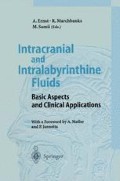Abstract
During the past two years the authors have diagnosed and treated three patients with classical symptoms and findings of perilymphatic fistula (PLF). The patients responded well initially to surgical closure of their PLFs, only to experience reoccurrence of their symptoms (vertigo and/or hearing fluctuation) within weeks or months after the repair. All were found to have elevated cerebrospinal fluid (CSF) pressure, which was felt to be responsible for excessive pressure transfer through the cochlear aqueduct to and through a vulnerable location in the oval or round window.
Access this chapter
Tax calculation will be finalised at checkout
Purchases are for personal use only
Preview
Unable to display preview. Download preview PDF.
References
Amaral F, Tsiaris W, Morgan T, Thompson WR (1987) Reversal of benign intracranial hypertension by surgically induced weight loss. Arch Surg 122:946–958
Corbut JJ, Sarino PJ, Thompson HS, Kansu T, Schantz NJ, Hopson D (1982) Visual loss in pseudotumor cerebri. Arch Neurol 31:461–470
Escate E (1875) Ecoulement spontane de liquide cephalo-sachidien par le conduit auditif externe. Arch Int Lang 10:653–656
Farrior JB (1962) Abstruse complications of stapes surgery. In: International symposium of otosclerosis. Boston, Little Brown, p 509
Fee GA (1968) Traumatic perilymphatic fistula. Arch Otolaryngol 88:477–488
Goodhill V (1971) Sudden deafness and round window rupture. Laryngoscope 81:1462–1470
Goodhill V, Harns I, Brockman SJ (1973) Sudden deafness and labyrinthine window ruptures, audio-vestibular observations. Ann Otol Rhinol Laryngol 82:2–12
Lehrer JF, Poole DC, Sigal B (1980) Use of glycerin test in the diagnosis of posttraumatic perilymph fistulas. Am J Otolaryngol 1:207–218
Lewis ML Jr (1961) Inner ear complications of stapes surgery. Laryngoscope 71:377–382
Newborg B (1974) Pseudotumor cerebri treated by rice/reduction diet. Arch Int Med 133:102–106
Quincke H (1897) Ober Meningitis serosa and verwandte Zustände. Z Nervhlk 9: 168
Reid A, Marchbanks RJ, Bürge DM, Martin AM, Bateman DE, Pickard JD, Brightwell AP (1990) The relationship between intracranial pressure and tympanic membrane displacement. Br J Audiol 24:123–133
Sismanis A (1987) Otologic manifestations of benign intracranial hypertension syndrome: diagnosis and management. Laryngoscope Suppl 42
Sismanis A, Butts FM, Hughes GB (1990) Objective tinnitus in benign intracranial hypertension: an update. Laryngoscope 100:33–43
Wall M, George D (1991) Idiopathic intracranial hypertension, a prospective study of 50 patients. Brain 114:155–164
Weider DJ, Geurkink NA, Saunders RL (1985) Spontaneous cerebrospinal fluid otorhinorrhea. Am J Otolaryngol 6:416–427
Weider DJ, Johnson GD (1988) Perilymphatic fístula: a New Hampshire experience. Am J Otol 9:184–189
Weider DJ, Saunders RL, Musiek E (1991) Repair of a cerebrospinal fluid perilymph fistula primarily through the middle ear and secondarily by occluding the cochlear aqueduct. Otolaryngol Head Neck Surg 105:35–42
Wlodyka J (1978) Studies of cochlear aqueduct patency. Ann Otol Rhinol Laryngol 77:22–29
Author information
Authors and Affiliations
Editor information
Editors and Affiliations
Rights and permissions
Copyright information
© 1996 Springer-Verlag Berlin Heidelberg
About this paper
Cite this paper
Weider, D.J., Saunders, R.L. (1996). Recurrent perilymphatic fistula as the initial and prime symptom of pseudotumor cerebri: Diagnosis and management with lumbarperitoneal shunt—Report of three cases. In: Ernst, A., Marchbanks, R., Samii, M. (eds) Intracranial and Intralabyrinthine Fluids. Springer, Berlin, Heidelberg. https://doi.org/10.1007/978-3-642-80163-1_38
Download citation
DOI: https://doi.org/10.1007/978-3-642-80163-1_38
Publisher Name: Springer, Berlin, Heidelberg
Print ISBN: 978-3-642-80165-5
Online ISBN: 978-3-642-80163-1
eBook Packages: Springer Book Archive

